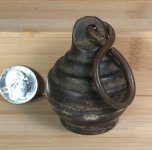F
fbeal
Guest
Some questions:
I hiked up to a couple of old digs this weekend and did some detecting. Lots of blasting caps and nails in the tailings. One large piece of quartz sounded off with the detector. When I broke it open each piece would sound off as well.
Inside the rock was a greenish metallic looking mineral(?) I assumed it was a pyrite but that wouldn't be picked up by the Gold Bug II would it?
Also, can there be valuable ore in which gold would not be visible? Should I have the rock assayed?
There are areas of float on the slopes below. Some have a red color on parts.
At one of the digs they had built a sort of oven out of rock and firebrick. I have heard of "cooking" ore but don't know much about it. Were they cooking this quartz that contained the pyrite?
Thanks for the info on my other posts.
Lanny, got any more good stories to tell? You should publish them in a magazine!
I hiked up to a couple of old digs this weekend and did some detecting. Lots of blasting caps and nails in the tailings. One large piece of quartz sounded off with the detector. When I broke it open each piece would sound off as well.
Inside the rock was a greenish metallic looking mineral(?) I assumed it was a pyrite but that wouldn't be picked up by the Gold Bug II would it?
Also, can there be valuable ore in which gold would not be visible? Should I have the rock assayed?
There are areas of float on the slopes below. Some have a red color on parts.
At one of the digs they had built a sort of oven out of rock and firebrick. I have heard of "cooking" ore but don't know much about it. Were they cooking this quartz that contained the pyrite?
Thanks for the info on my other posts.
Lanny, got any more good stories to tell? You should publish them in a magazine!
Amazon Forum Fav 👍
Upvote
0



